The following picture is retrieved from Wikipedia:

I haven't understood this part:

I have two questions here:
- Where did they obtain [8,4,1,2] from and what did they want to tell us by that?
- Take a look at cell
[0, 0]whose value is13. If I go clockwise along with its contouring values, I obtain the binary string0010which is2. How does the 1st cell-value become13?
.
enum What
{
lines, surface, both
}
class Program
{
public static void Print(int[,] data, int xn, int yn)
{
for (int j = 0; j < yn; j++)
{
for (int i = 0; i < xn; i++)
{
Console.Write(data[i,j] + ", ");
}
Console.WriteLine();
}
}
public static int[,] normalize(int[,] data, int xn, int yn)
{
for (int j = 0; j < yn; j++)
{
for (int i = 0; i < xn; i++)
{
if (data[i, j] > 1)
{
data[i, j] = 0;
}
else
{
data[i, j] = 1;
}
}
}
return data;
}
public static int[,] marching_square(int x, int y, int[,] data, int isovalue, What what)
{
int xn = x;
int yn = y;
data = normalize(data, xn, yn);
int[,] bitMask = new int[xn - 1, yn - 1];
for (int j = 0; j < yn - 1; j++)
{
for (int i = 0; i < xn - 1; i++)
{
StringBuilder sb = new StringBuilder();
sb.Append(data[i, j]);
sb.Append(data[i, j + 1]);
sb.Append(data[i + 1, j]);
sb.Append(data[i + 1, j + 1]);
bitMask[i, j] = Convert.ToInt32(sb.ToString(), 2);
}
}
return bitMask;
}
static void Main(string[] args)
{
int[,] data = new int[,] {
{ 1,1,1,1,1 },
{ 1,2,3,2,1 },
{ 1,3,3,3,1 },
{ 1,2,3,2,1 },
{ 1,1,1,1,1 }
};
Print(data, 5,5);
int[,] bitMask = marching_square(5,5,data, 0, What.lines);
Print(bitMask, 4, 4);
}
}
Output:
1, 1, 1, 1, 1,
1, 2, 3, 2, 1,
1, 3, 3, 3, 1,
1, 2, 3, 2, 1,
1, 1, 1, 1, 1,
14, 10, 10, 11,
12, 0, 0, 3,
12, 0, 0, 3,
13, 5, 5, 7,
I inverted the bits. But, the output looks different.